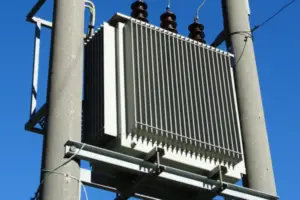As an electrical maintenance engineer, I know firsthand how important electrical transformers are to our power systems.
Transformers play a critical role in delivering electricity from power plants to homes and businesses by stepping up or down the voltage of the electricity.
But have you ever wondered why electrical transformers have oil in them? In this article, we’ll explore the role of oil in transformers and why it’s so important.
Table of Contents
Role of Oil in Electrical Transformers
When it comes to electrical transformers, the oil serves three primary purposes: cooling, insulation, and lubrication.
Cooling of Transformers
Transformers generate a lot of heat during operation, which can cause the components inside to overheat and fail.
This is where oil comes in. The oil inside a transformer acts as a coolant, helping to dissipate the heat and keep the components at a safe operating temperature.
The thermal conductivity of oil is much higher than air, which means it can transfer heat more efficiently.
Additionally, oil has a high heat capacity, which means it can absorb a lot of heat without getting too hot itself.
Read my in-depth article Transformer cooling system 5 answers for beginners.
Insulation of Transformers
Transformers also require insulation to prevent electrical arcing between the components.
Oil provides excellent insulation, as it has high dielectric strength and can withstand high voltages without breaking down.
This helps protect the transformer from damage and also ensures the safety of those working on or near the transformer.
Helps in case of faults
Yes, that’s correct. Analysis of the oil in transformers can provide important information about the condition of the transformer and help identify potential faults or issues.
The oil in transformers is tested regularly to monitor its condition, such as its dielectric strength, water content, and presence of contaminants or other impurities.
By analyzing the oil, electricians and maintenance engineers can detect any potential problems and take corrective action before they escalate into major faults or failures.
Regular oil analysis is an important part of transformer maintenance and can help extend the lifespan of the transformer while also improving its safety and reliability.
Corrosion protection
The oil in transformers also serves as a protective layer for the internal metallic parts, like the core and bolts.
These metal parts can rust and corrode over time due to exposure to air and moisture. The oil acts as a barrier between the metal parts and the air, which reduces the likelihood of corrosion.
Corrosion can weaken the structure of the transformer and cause leaks or other damage, so it’s important to protect against it.
Regular oil testing and analysis can help identify any signs of corrosion or other issues early on, so that they can be addressed before they become major problems.
Types of Transformer Oils
Several types of oil can be used in electrical transformers, each with its advantages and disadvantages.
The most common types are mineral oil, synthetic oil, and natural ester oil.
Mineral Oil Mineral
oil is the most widely used type of transformer oil, as it is inexpensive and readily available.
However, it is also highly flammable and can pose a safety hazard if not handled properly.
Synthetic Oil
Synthetic oils are more expensive than mineral oils, but they offer several advantages. For one, they are less flammable, making them safer to use.
They also have better oxidation stability, which means they can last longer without breaking down.
Natural Ester Oil
Natural ester oils are made from vegetable oils and are biodegradable, making them a more environmentally friendly option.
They are also less flammable than mineral oil and have excellent insulation properties. However, they are more expensive than mineral oil and may not be suitable for all transformer applications.
Maintenance of Transformer Oil
Proper maintenance of transformer oil is crucial to ensuring the transformer operates safely and efficiently.
Regular oil testing is necessary to monitor the condition of the oil and detect any issues before they become serious problems.
Oil filtration and purification are also important to remove any contaminants that may have entered the transformer.
For more information visit my safetyfrenzy site and check ou this article Preventing Transformer Fires with Regular Maintenance
Environmental Considerations
Transformer oil can have a significant impact on the environment if not handled properly. Oil leaks and spills can contaminate soil and water, harming wildlife and ecosystems.
It’s important to follow regulations and guidelines for transformer oil use and disposal to minimize the environmental impact.
Conclusion
In conclusion, the role of oil in electrical transformers cannot be overstated. It serves as a coolant, insulator, and lubricant, keeping the transformer operating safely and efficiently.
Different types of oil have their advantages and disadvantages, and proper maintenance and handling are crucial to ensuring the safety of the transformer and the environment.
Don’t Leave Empty-Handed!
Install my Free Android App on Google Play:
Electrical Cables Most Common Tables “Cables Tables”
And, my Electrical Calculations App “Fast Electrical Calculator”
Discover more great content by subscribing to My channel
Looking to stay ahead of the game in the world of electrical engineering? Subscribe to my YouTube channel and gain access to exclusive content you won’t find anywhere else!
The staff I recommend
(Amazon Affiliate Links to products I believe are high quality):
- Economy 120 Volt/60Hz AC Power Source – Step-Down Voltage & Frequency Converters 1800W
- UNI-T Digital Multimeter Tester UT139C
- 50-Amp Extension Cord for RV “100ft”
- Voltage Stabilizer 110/220v
- Hair Dryer “best selling“
- TOSHIBA EM131A5C-BS Countertop Microwave Ovens
Disclaimer: This contains affiliate links to Amazon products. I may earn a commission for purchases made through these links.



